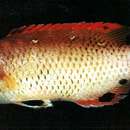Diagnostic Description
provided by Fishbase
This species is distinguished by the following characters: D XII,10; A III,12; caudal-fin rays 10 - 11 (4) + 12 + 10; pectoral-fin rays ii, 11-15 (3); predorsal scales ?22-25; total gill rakers 15 or 17; head and snout elongate; jaws attenuate; the cheek scales reaching forward on upper side of mouth to below or slightly in advance of anterior extent of orbit, scales reaching forward on lower jaw slightly in advance of posterior corner of mouth; one scale usually apparent midway between corner of mouth and anterior tip of jaw; the upper jaw with first prominent anterior canine equal to or slightly smaller than second; first canine directed anteroventrally, the tip often curved ventrally; second canine directed ventrolaterally and slightly anteriorly, tip occasionally curved ventrally; dental ridge mostly straight with ?6-21 very small canines; one moderately large prominent canine at posterior end of jaw directed anteroventrally and slightly laterally in small individuals, directed more anteriorly in larger specimens; the lower jaw with first prominent anterior canine ?2/3-3/4 length of second; the first canine is directed anterodorsally and usually slightly laterally, tip often curved dorsally; dental ridge usually long and continuous with about 15-22 very small canines in a single row; the teeth becoming only slightly larger posteriorly; teeth occasionally separable into 2 series; the pelvic fin is short, its posterior tip approaching anus only in small individuals (Ref. 75973).
- Recorder
- Estelita Emily Capuli
Life Cycle
provided by Fishbase
Oviparous, distinct pairing during breeding (Ref. 205).
Morphology
provided by Fishbase
Dorsal spines (total): 12; Dorsal soft rays (total): 10; Analspines: 3; Analsoft rays: 12
- Recorder
- Estelita Emily Capuli
Biology
provided by Fishbase
Adults are found in coral rich areas of seaward reefs (Ref. 5213). Reported to be associated with the mushroom Heliofungia actiniformis (Ref. 91291). Oviparous, distinct pairing during breeding (Ref. 205).
- Recorder
- Estelita Emily Capuli
Importance
provided by Fishbase
fisheries: minor commercial; aquarium: commercial; price category: very high; price reliability: very questionable: based on ex-vessel price for species in this family
- Recorder
- Estelita Emily Capuli
分布
provided by The Fish Database of Taiwan
分布於印度-太平洋區,由紅海、南非到馬歇爾群島和薩摩亞,北至日本琉球與台灣海域等。台灣各地海域皆有分布。
利用
provided by The Fish Database of Taiwan
中小型之隆頭魚,雖然肉質好,且具有膠黏性,非常適合紅燒,但是因為產量不多,所以並不具有經濟價值,只偶爾出現在漁市場和水族館。漁法主要為手釣及底延繩釣。
描述
provided by The Fish Database of Taiwan
體長型;頭部背面輪廓幾成直線。上下頜突出,前側各具
4犬齒,上頜兩側各具
1大圓犬齒。頰部與鰓蓋被鱗,側線平滑連續。D. XII,
9-10;A. III, 10-12; P. 16;L.l. 31-32;G.R.
5-10;尾鰭稍圓,上下鰭條延長。幼魚體呈褐色而散佈許多白色橢圓班;背鰭之前及後端、臀鰭中央及後端、胸鰭基部、腹鰭及尾鰭基部中央皆具一眼班。成魚頭部體紅褐色,體側淡黃色,背部偏紅,腹部較淡;體背後部與尾柄上半部具小黑點;背鰭下方具
3-4個成一列的白點;奇鰭紅色;腹鰭幾乎全為黑色;臀鰭中央具一大黑斑,末端基部具一小黑點;尾鰭基部中央有一黑點。
棲地
provided by The Fish Database of Taiwan
主要棲息於水深10到20公尺處的礁岩海域,尤其是礁岩向海面珊瑚繁茂的區域,但分布的深度範圍很廣,可以從水深5公尺到水深100公尺。棲所環境和腋斑狐鯛相似。幼魚時常躲在黑色珊瑚和柳珊瑚附近,也常躲在穴頂下方,常客串魚醫生為其它魚清除身上的寄生蟲。成魚專門吃岩石縫下的甲殼類和貝類,夜晚則躲在岩石下面或洞穴裏睡覺。
Diana's hogfish
provided by wikipedia EN
- license
- cc-by-sa-3.0
- copyright
- Wikipedia authors and editors
Diana's hogfish: Brief Summary
provided by wikipedia EN
Diana's hogfish, Bodianus diana, is a species of wrasse native to the Indian Ocean from the African coast to the Nicobars and the Cocos-Keeling Islands. Reports of its presence in the western Pacific Ocean are erroneous. It occurs on the seaward side of reefs at depths from 6 to 50 m (20 to 164 ft) (though rarely deeper than 25 m (82 ft)). It can reach a length of 16.9 cm (6.7 in). This species is of minor importance to local commercial fisheries and is found in the aquarium trade.
- license
- cc-by-sa-3.0
- copyright
- Wikipedia authors and editors
Description
provided by World Register of Marine Species
Found in coral rich areas of seaward reefs (Ref. 5213). Juveniles often shelter near black corals and gorgonians; also frequent cave ceilings (Ref. 8631). Feeds mainly on benthic invertebrates such as molluscs and crustaceans.
Froese, R. & D. Pauly (Editors). (2023). FishBase. World Wide Web electronic publication. version (02/2023).
- license
- cc-by-4.0
- copyright
- WoRMS Editorial Board

